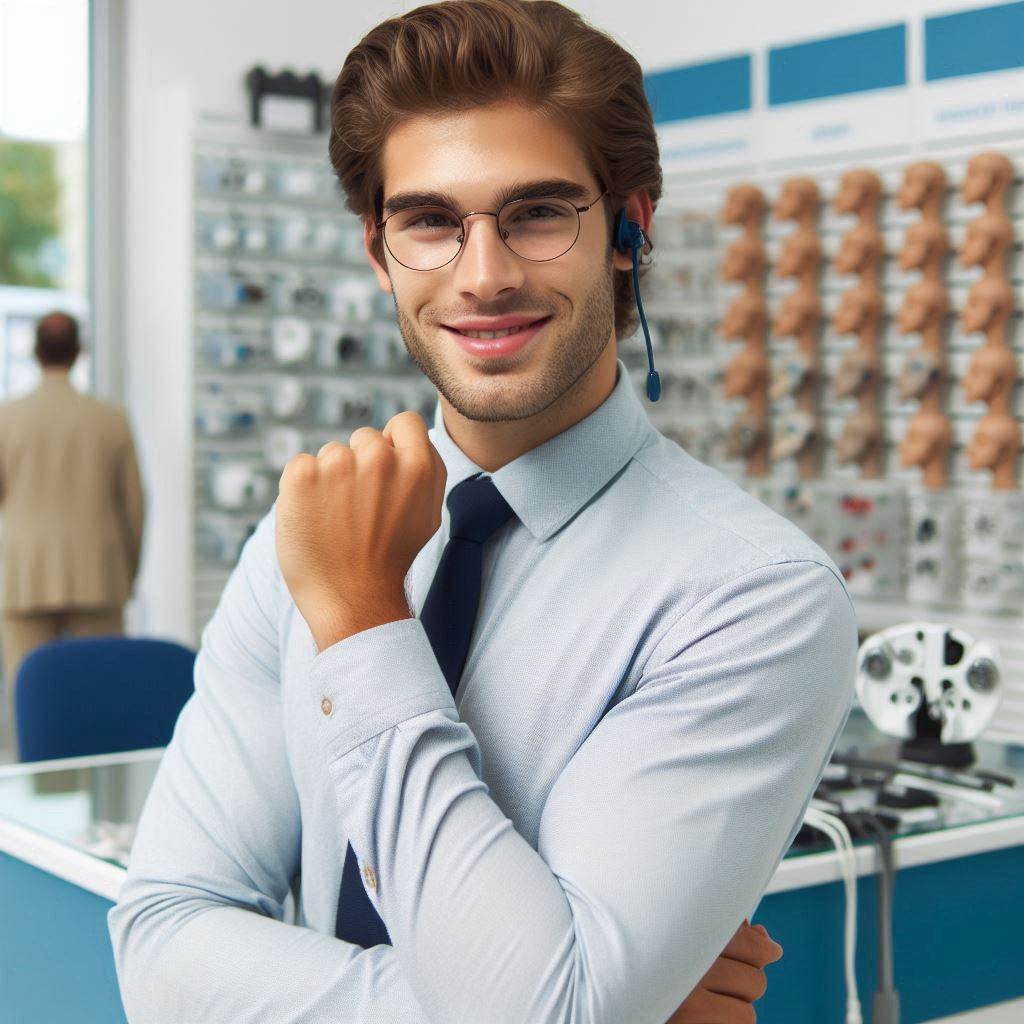Introduction
Audiologists play a pivotal role in occupational hearing conservation, serving as key professionals in the prevention, identification, and management of hearing loss in the workplace.
Their primary role involves designing and implementing hearing conservation programs tailored to the specific needs of various industries.
These programs aim to protect workers from the detrimental effects of noise exposure, ensuring a safer and healthier work environment.
The importance of protecting workers’ hearing cannot be overstated.
Prolonged exposure to high levels of noise can lead to permanent hearing loss, which significantly impacts an individual’s quality of life and productivity.
Hearing loss not only affects communication but also increases the risk of accidents and injuries due to the inability to hear warning signals.
Consequently, preserving hearing health is essential for both the well-being of employees and the operational efficiency of organizations.
Audiologists bring a wealth of skills and expertise to occupational hearing conservation.
They are trained to conduct comprehensive hearing assessments, including audiometric testing, to monitor workers’ hearing over time.
Audiologists also possess the knowledge to analyze workplace noise levels and identify high-risk areas.
By utilizing this data, they can recommend and implement effective noise control measures, such as engineering controls, administrative controls, and personal protective equipment (PPE).
Furthermore, audiologists are adept at educating both employers and employees about the significance of hearing conservation.
They provide training on the correct use and maintenance of hearing protection devices, fostering a culture of hearing health awareness in the workplace.
Their ability to communicate complex information in an accessible manner ensures that all stakeholders understand the importance of preserving hearing.
In summary, audiologists are indispensable in occupational hearing conservation.
Their expertise in hearing health, noise assessment, and education ensures that workers are protected from the harmful effects of noise exposure.
By safeguarding hearing, audiologists contribute to a safer, more productive work environment, ultimately enhancing the overall quality of life for employees.
Conducting Hearing Screenings
How audiologists are responsible for conducting audiometric screenings to assess workers’ hearing abilities
Audiologists play a vital role in occupational hearing conservation by conducting audiometric screenings to assess workers’ hearing abilities.
These screenings are essential in detecting any signs of hearing loss among employees, especially those exposed to hazardous noise levels in their workplace.
Audiologists are trained to perform comprehensive hearing tests, utilizing sophisticated audiometric equipment to measure hearing thresholds and identify any deviations from normal hearing.
Transform Your Career Today
Unlock a personalized career strategy that drives real results. Get tailored advice and a roadmap designed just for you.
Start NowThe importance of early detection of hearing loss in preventing further damage
Early detection of hearing loss is crucial in preventing further damage and preserving workers’ hearing health.
Hearing loss often develops gradually, making it difficult for individuals to notice until significant damage has occurred.
By conducting regular hearing screenings, audiologists can identify early signs of hearing impairment, allowing for timely intervention.
Early detection enables the implementation of preventive measures such as hearing protection devices and modifications to work environments to reduce noise exposure.
This proactive approach helps in mitigating the progression of hearing loss and maintaining the overall well-being of employees.
The role of audiologists in developing baseline audiograms for comparison in future screenings
Another significant responsibility of audiologists in occupational hearing conservation is developing baseline audiograms.
A baseline audiogram serves as a reference point for each worker’s hearing abilities at the start of their employment or before exposure to noisy environments.
This initial audiogram is crucial for future comparisons, enabling audiologists to detect any changes or deterioration in hearing over time.
Regular follow-up screenings can then be compared to the baseline audiogram to identify any shifts in hearing thresholds, indicating potential hearing damage. This process ensures that any hearing loss is promptly addressed and managed.
In summary, audiologists are instrumental in conducting hearing screenings to assess and monitor workers’ hearing abilities.
Their expertise in early detection and the development of baseline audiograms is essential in preventing further hearing damage and ensuring a safe and healthy working environment.
Through these efforts, audiologists contribute significantly to the preservation of hearing health in the occupational setting.
Read: What Does an Audiologist Do? A Comprehensive Guide
Developing Hearing Conservation Programs
Creating and implementing comprehensive hearing conservation programs in workplace settings is a critical task to prevent noise-induced hearing loss.
Audiologists play a central role in this process, ensuring that both employers and employees understand and prioritize hearing protection.
Creating and Implementing Programs
The development of a hearing conservation program begins with a thorough assessment of workplace noise levels.
Audiologists conduct detailed noise surveys, identifying areas and tasks with hazardous noise exposure.
Following this, they establish a baseline hearing assessment for employees, using audiometric testing to detect any pre-existing hearing loss.
Based on these evaluations, audiologists design a tailored hearing conservation program, incorporating strategies such as engineering controls to reduce noise at the source, administrative controls to limit exposure duration, and personal protective equipment (PPE).
Showcase Your Business Today
Reach thousands of readers actively exploring professional services. Publish your business profile and grow your audience now.
Publish NowEducation and Training
Educating employers and employees is a crucial step in ensuring the effectiveness of hearing conservation programs.
Audiologists conduct training sessions to highlight the risks of noise-induced hearing loss and the importance of hearing protection.
These sessions often include demonstrations on the correct use of hearing protection devices, reinforcing the significance of consistent and proper usage.
Audiologists also develop educational materials, such as posters and pamphlets, to remind employees of best practices for hearing conservation.
Engaging both management and staff fosters a culture of safety and health within the workplace.
Hearing Protection Devices
Recommending and fitting hearing protection devices (HPDs) is another vital aspect of an audiologist’s role.
They assess the specific noise environment and the individual needs of workers to suggest appropriate HPDs, such as earplugs or earmuffs.
Custom-fitted earplugs are often recommended for optimal protection and comfort.
Audiologists ensure that these devices provide adequate attenuation to prevent hearing damage without compromising communication or job performance.
Regular monitoring and refitting sessions are conducted to maintain the effectiveness of HPDs over time.
In summary, audiologists are instrumental in developing, implementing, and maintaining hearing conservation programs.
Their expertise ensures that workplaces not only comply with regulations but also safeguard the hearing health of their employees, fostering a safer and healthier work environment.
Read: Unveiling the Role of a Diagnostic Doctor in the US

Monitoring noise levels in the workplace
Audiologists use specialized equipment like sound level meters to measure noise levels in different work environments.
It is crucial for audiologists to identify areas with high noise exposure to prevent potential hearing loss in workers.
Audiologists play a key role in recommending noise control measures such as engineering controls or personal protective equipment.
How Audiologists Measure Noise Levels
Audiologists utilize sophisticated sound level meters that accurately measure the intensity of noise in decibels.
These measurements are taken at various locations within the workplace to identify areas with excessive noise levels.
Audiologists also assess the duration of exposure to determine the risk of hearing damage for workers.
Importance of Identifying High Noise Exposure Areas
Identifying areas with high noise exposure is essential in preventing noise-induced hearing loss among workers.
Early detection allows audiologists to implement intervention strategies to protect employees’ hearing health.
By pinpointing high-risk areas, audiologists can work with employers to reduce noise exposure and create a safer work environment.
Role of Audiologists in Recommending Noise Control Measures
Audiologists provide expert guidance on implementing noise control measures to minimize exposure in the workplace.
This may involve recommending engineering controls such as noise barriers or administrative controls like job rotation.
Audiologists also advise on the use of personal protective equipment such as earplugs or earmuffs to reduce noise exposure.
In short, audiologists play a crucial role in occupational hearing conservation by monitoring noise levels, identifying high-risk areas, and recommending effective noise control measures to protect workers’ hearing health.
Their expertise and specialized equipment are instrumental in creating safer work environments and preventing noise-induced hearing loss.
Read: Becoming a Physical Therapist: Steps & Requirements in the USA
Providing education on hearing loss prevention
How audiologists educate workers on the impact of noise-induced hearing loss and the importance of protecting their hearing
Audiologists play a critical role in occupational hearing conservation, particularly through educating workers on the prevention of noise-induced hearing loss (NIHL).
NIHL, a significant risk in many industries, can lead to permanent hearing damage if not properly addressed.
Audiologists educate workers about the impact of excessive noise exposure on hearing.
They explain how prolonged exposure to high decibel levels can damage the hair cells in the inner ear, leading to permanent hearing loss.
By detailing the physiological effects of noise on hearing, audiologists help workers understand the serious, long-term consequences of inadequate hearing protection.
The role of audiologists in training employees on proper use of hearing protection devices
Beyond raising awareness, audiologists train employees on the proper use of hearing protection devices (HPDs).
This includes comprehensive instruction on the different types of HPDs, such as earplugs and earmuffs, and their appropriate use in various noise environments.
Audiologists demonstrate the correct fitting techniques to ensure maximum effectiveness, emphasizing the importance of consistent use.
They also educate workers on the maintenance and replacement of these devices to ensure they continue to provide adequate protection.
This hands-on training is crucial, as improper use of HPDs can significantly reduce their effectiveness, leaving workers vulnerable to NIHL.
The significance of ongoing education and counseling provided by audiologists to promote hearing health in the workplace
Ongoing education and counseling provided by audiologists are vital for promoting hearing health in the workplace.
Audiologists offer regular workshops and refresher courses to reinforce the importance of hearing conservation practices.
Showcase Your Business Today
Reach thousands of readers actively exploring professional services. Publish your business profile and grow your audience now.
Publish NowThey provide personalized counseling to workers, addressing individual concerns and ensuring compliance with hearing protection protocols.
This continuous education helps to keep hearing conservation at the forefront of workers’ minds, fostering a culture of safety and health.
In essence, audiologists are essential in occupational hearing conservation.
Through education on the impact of noise-induced hearing loss, training on proper use of hearing protection devices, and ongoing counseling, they ensure that workers are well-informed and protected, promoting long-term hearing health in the workplace.
Read: Tele-dentistry in the USA: The Future or a Fad?
Explore Further: Day in the Life: Inside a Registered Dietitian’s Job
Uncover the Details: Tips for Success in Sonography School and Training
Collaborating with occupational health and safety professionals
Partnership between audiologists and occupational health and safety professionals
Audiologists play a crucial role in occupational hearing conservation by partnering with occupational health and safety professionals.
This collaboration ensures that employees are protected from workplace hazards that could lead to hearing loss.
By working together, audiologists and occupational health and safety professionals can implement comprehensive hearing conservation programs that are tailored to the specific needs of the workforce.
Audiologists work with other professionals to assess workplace hazards
In order to effectively address workplace hazards that may contribute to hearing loss, audiologists work closely with other professionals such as industrial hygienists and safety engineers.
By conducting thorough assessments of the work environment, audiologists can identify potential risks and develop strategies to mitigate them.
This collaborative approach ensures that all aspects of occupational health and safety are considered in the development of hearing conservation programs.
Benefits of interdisciplinary collaboration in promoting a safe work environment
The benefits of interdisciplinary collaboration between audiologists and occupational health and safety professionals are numerous.
By working together, these professionals can leverage their unique expertise to create a comprehensive approach to hearing conservation.
This not only helps prevent hearing loss among employees but also promotes a safe and healthy work environment overall.
Additionally, the sharing of knowledge and resources between different disciplines fosters innovation and continuous improvement in occupational health and safety practices.
Basically, the collaboration between audiologists and occupational health and safety professionals is essential in implementing effective hearing conservation programs.
By pooling their expertise and resources, these professionals can create a safe and healthy work environment for employees while minimizing the risk of hearing loss.
It is through interdisciplinary collaboration that the goals of occupational hearing conservation can be achieved successfully.
Conclusion
Audiologists play a crucial role in occupational hearing conservation by conducting hearing screenings and assessments.
They develop and implement hearing conservation programs, provide education on hearing protection, and recommend appropriate hearing protection devices.
Audiologists also collaborate with employers to ensure compliance with OSHA regulations and provide ongoing support for workers with hearing loss.
The importance of audiologists in protecting workers’ hearing and promoting hearing health in the workplace cannot be underestimated.
Employers should prioritize hearing conservation efforts and seek out audiologists for expert guidance and support to create a safe and healthy work environment for all employees.
[E-Books for Sale]
The Big Book of 500 High-Paying Jobs in America: Unlock Your Earning Potential
$19.99 • 500 High-Paying Jobs • 330 pages
Explore 500 high-paying jobs in America and learn how to boost your career, earn more, and achieve success!
See All 500 High-Paying Jobs of this E-Book
1001 Professions Without a Degree: High-Paying American Jobs You Can Start Now
$19.99 • 1001 Professions Without a Degree • 174 pages
Discover 1001 high-paying jobs without a degree! Unlock career tips, skills, and success strategies for just $19.99!




